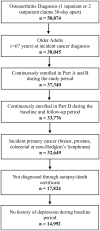Prescription Non-Steroidal Anti-Inflammatory Drugs (NSAIDs) and Incidence of Depression Among Older Cancer Survivors With Osteoarthritis: A Machine Learning Analysis
- PMID: 37101728
- PMCID: PMC10123903
- DOI: 10.1177/11769351231165161
Prescription Non-Steroidal Anti-Inflammatory Drugs (NSAIDs) and Incidence of Depression Among Older Cancer Survivors With Osteoarthritis: A Machine Learning Analysis
Abstract
Objectives: This study examined prescription NSAIDs as one of the leading predictors of incident depression and assessed the direction of the association among older cancer survivors with osteoarthritis.
Methods: This study used a retrospective cohort (N = 14, 992) of older adults with incident cancer (breast, prostate, colorectal cancers, or non-Hodgkin's lymphoma) and osteoarthritis. We used the longitudinal data from the linked Surveillance, Epidemiology, and End Results -Medicare data for the study period from 2006 through 2016, with a 12-month baseline and 12-month follow-up period. Cumulative NSAIDs days was assessed during the baseline period and incident depression was assessed during the follow-up period. An eXtreme Gradient Boosting (XGBoost) model was built with 10-fold repeated stratified cross-validation and hyperparameter tuning using the training dataset. The final model selected from the training data demonstrated high performance (Accuracy: 0.82, Recall: 0.75, Precision: 0.75) when applied to the test data. SHapley Additive exPlanations (SHAP) was used to interpret the output from the XGBoost model.
Results: Over 50% of the study cohort had at least one prescption of NSAIDs. Nearly 13% of the cohort were diagnosed with incident depression, with the rates ranging between 7.4% for prostate cancer and 17.0% for colorectal cancer. The highest incident depression rate of 25% was observed at 90 and 120 cumulative NSAIDs days thresholds. Cumulative NSAIDs days was the sixth leading predictor of incident depression among older adults with OA and cancer. Age, education, care fragmentation, polypharmacy, and zip code level poverty were the top 5 predictors of incident depression.
Conclusion: Overall, 1 in 8 older adults with cancer and OA were diagnosed with incident depression. Cumulative NSAIDs days was the sixth leading predictor with an overall positive association with incident depression. However, the association was complex and varied by the cumulative NSAIDs days.
Keywords: NSAIDs; Osteoarthritis; cancer; depression; inflammation; machine learning; older adults.
© The Author(s) 2023.
Conflict of interest statement
The author(s) declared no potential conflicts of interest with respect to the research, authorship, and/or publication of this article.
Figures




References
-
- Ismail Z, Elbayoumi H, Fischer CE, et al.. Prevalence of depression in patients with mild cognitive impairment: A systematic review and meta-analysis. JAMA Psychiatr. 2017;74:58-67. - PubMed
-
- Luppa M, Sikorski C, Luck T, et al.. Age- and gender-specific prevalence of depression in latest-life – systematic review and meta-analysis. J Affect Disord. 2012;136:212-221. - PubMed
LinkOut - more resources
Full Text Sources

